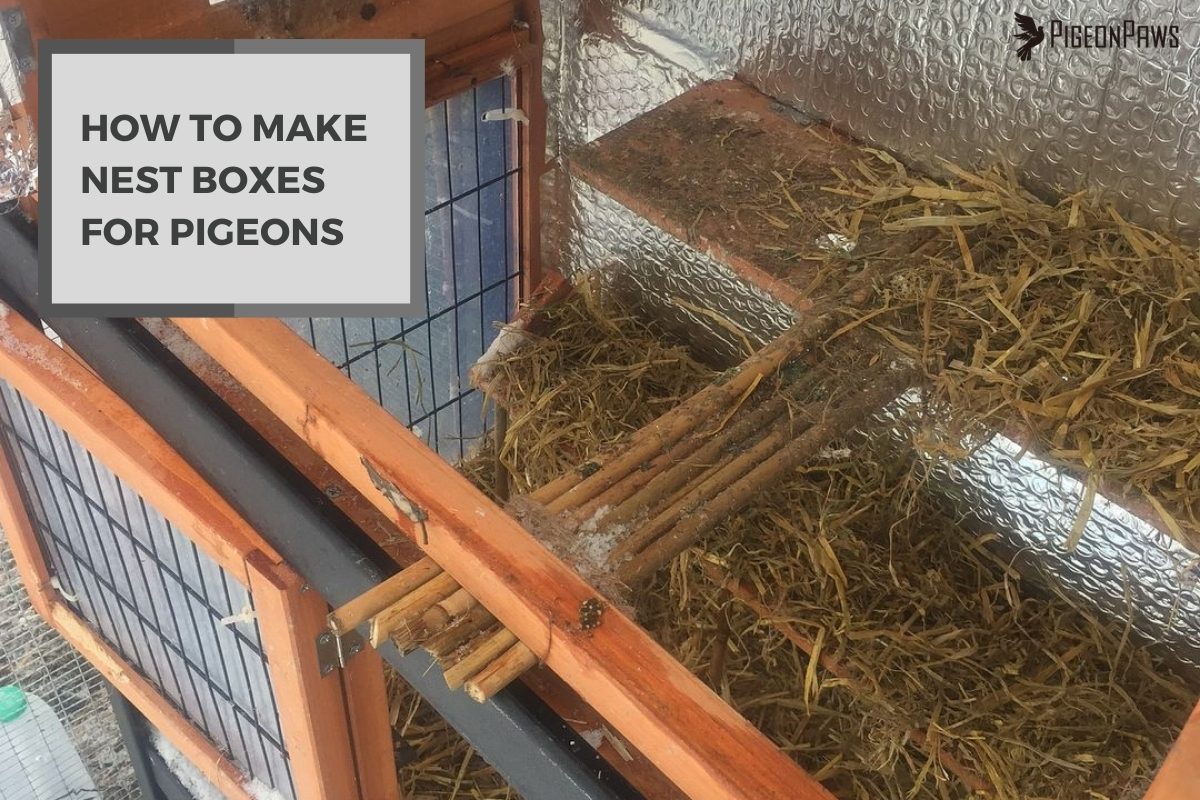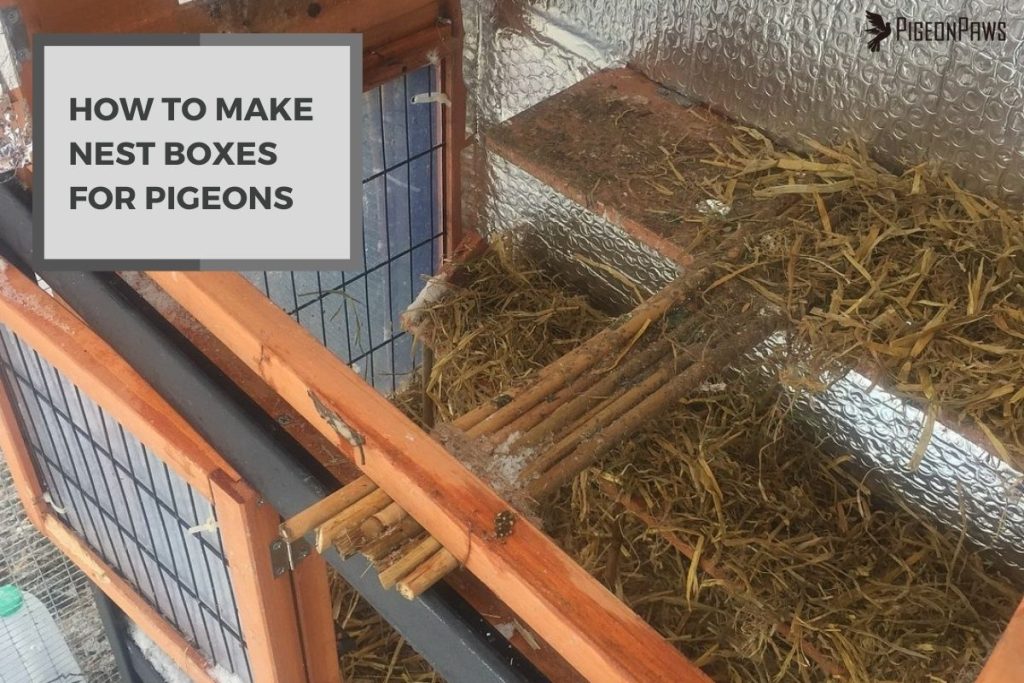How to Make Nest Boxes for Pigeons? Easy-to-Follow Guide

Nest boxes provide pigeons with an ideal environment for laying eggs and raising young. These structures can be constructed from wood, concrete, or brick and come in various sizes and designs. Building a nest box is a simple and effective way of helping to protect and support the local pigeon population.
To fabricate a nest box for pigeons, one will require some basic materials such as plywood, nails, screws, and a drill. Quality material is resistant to inclement weather conditions should be used for optimal results. It is suggested that the nest box have dimensions of approximately 24 inches in length, 17 inches deep, and 18 inches high.
In this article, I’ll cover everything you need to know about how to make nest boxes for pigeons, from the materials to the best location selection to place the box and many more.

What Materials Do You Need to Make A Nest Box for Pigeons?
When it comes to building a nest box for pigeons, there are a few key materials you’re going to need to have on hand. First and foremost, you’re going to need some wood. Now, you can use plywood, hardwood, or even softwood; it doesn’t really matter as long as it’s durable and can withstand the elements.
Nails And Screws
In addition to the wood, you’ll also need some nails and screws to hold everything together. Now, I recommend using galvanized or stainless steel nails and screws because they will be less likely to rust and deteriorate over time. And trust me, you don’t want your nest box falling apart after a couple of months.
Drill
You’re also going to need a drill. Now, you don’t need some fancy industrial drill; a basic cordless drill will do the trick. But make sure you have a decent battery because you don’t want to run out of juice halfway through the project.
What Are The Dimensions of A Suitable Nest Box for Pigeons?
The box’s size and dimensions, in addition to the materials employed, are crucial when building a pigeon nest box. Ensure the box is big enough for the pigeons to raise their young and lay their eggs comfortably but not too big that it becomes dangerous.
Width And Length
A suitable nest box for pigeons should be around 24 inches in length and 17 inches deep. This will give the pigeons enough room to move around and make themselves comfortable, but not so much that it becomes a challenge to keep the box clean.
Height
In terms of height, it’s recommended that the nest box be around 18 inches high. This will give the pigeons enough headroom to stand up and move around but also keep the entrance hole at a safe distance from the floor to prevent predators from getting inside.
Entrance Hole
The entrance hole should be around 2 inches in diameter. This will allow the pigeons to enter and exit the box comfortably and keep larger birds or predators from getting inside.
It’s also worth noting that the nest box should have a sloped roof to keep out rain and a recessed floor with drainage holes to keep the interior dry.
How Do You Assemble The Nest Box?
Now that you’ve got your materials and know the recommended dimensions for the nest box, it’s time to start putting it all together. Building a nest box for pigeons is a fairly simple process, but it’s important to pay attention to the details and take your time to ensure that everything is done correctly.
Step 1: Cutting The Wood
You’ll need to cut the wood to the appropriate size. Use a saw or a jigsaw to cut the pieces according to the dimensions discussed in the previous section. Make sure to measure twice and cut once to avoid any mistakes.
Step 2: Drilling Guide Holes
Next, drill guide holes in the nest box’s front, right side, and back. These guide holes will be used later on to secure the roof to the nest box.
Step 3: Assembling The Box
Once you have the pieces cut and the guide holes drilled, it’s time to start assembling the box. Use the nails or screws to attach the back panel to the roof panels. Then attach the front and floor panels to the back and roofing panels. And finally, attach the lintels to the box.
Step 4: Attaching The Roof
After the box has been assembled, the roof must be attached. Place the roof on top of the nest box, with the gutters on the underside. To attach the roof to the box, use the previously drilled guide holes. Remember that there should be no screws on the left side of the nest box to allow for easy cleaning.
Following these steps, you should have a sturdy and well-built nest box that will provide a safe and comfortable home for the pigeons.
Where Should You Place The Nest Box?
You’ve got your nest box built, but now it’s time to decide where to put it. The location of the nest box is just as important as the materials and dimensions used to construct it. Pigeons need a safe and secluded spot to call home, and it’s up to us to provide that for them.
Quiet And Secluded Area
The best location for a nest box is in a quiet and secluded area. Pigeons need a peaceful environment to raise their young and feel safe, so it’s important to avoid placing the box in busy areas where there’s a lot of human activity or noise.
Near A Food Source
Pigeons also need a reliable food source nearby. It’s a good idea to place the nest box near a park or an area where pigeons are known to forage for food. This way, they will have easy access to the resources they need to survive.
Protection From Predators
Another important factor to consider when placing the nest box is protection from predators. Pigeons are vulnerable to attack from birds of prey, cats, and other animals. So, it’s important to place the nest box in an area that’s out of reach of these predators.
Accessibility
Make sure the nest box is easily accessible for cleaning and monitoring but also not too visible to discourage predators.
How Do You Maintain The Nest Box?
The construction of a nest box is only the first step in assisting local pigeon populations. Keeping the nest box clean and in good condition is critical to ensure that the pigeons continue to use it. Regular maintenance will also help to keep the birds healthy and free of disease and parasites.
Cleaning The Box
Cleaning the nest box is crucial to maintaining a healthy environment for the pigeons. The box should be cleaned out at least once a year, preferably at the end of the breeding season.
This will help to remove any old nesting materials, feces, and parasites. When cleaning the box, use mild detergent and warm water, and be sure to wear gloves to protect yourself from any diseases that may be present.
Inspecting The Box
Regular inspections of the nest box will aid in the early detection of any potential problems. Examine the item for signs of wear and tear, such as holes or cracks, and make any necessary repairs. Look for signs of pests or parasites, such as mites, and take the necessary steps to eliminate them.
Protecting from Weather
Protecting the nest box from the elements is also important. Make sure the box is properly sealed and that the roof is in good condition to keep out the rain. It’s also a good idea to place the box in a location protected from strong winds.
Monitoring The Box
Monitoring the nest box will help you to keep track of how often it’s being used and by which species. This will give you an idea of the nest box’s success and allow you to make adjustments if necessary.
Pigeon Nest Box Building Tutorial
Will Building Nest Boxes for Pigeons Keep Them Away from My Balcony?
Building nest boxes for pigeons will not keep them away from your balcony. In fact, it may attract more of them. To deter pigeons, it’s better to focus on other methods. Explore 10 methods to keep pigeons away, such as using bird spikes, decoy predators, or ultrasonic devices. These techniques can help create a pigeon-free balcony space.
Conclusion
Building a nest box for pigeons is a simple and rewarding project that can make a big difference for these birds. By providing a safe and comfortable home, we can support local pigeon populations and improve their habitat.
This guide has covered everything you need to know about making a nest box for pigeons, from the materials you’ll need, the recommended dimensions, assembly, the best location to place the box, and how to maintain it.
By following these guidelines, you’ll be able to create a nest box that will be a valuable resource for local pigeons. The project is not only easy but also budget-friendly, so don’t hesitate to try it and positively impact your local ecosystem.

